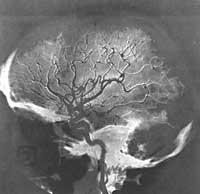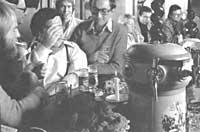Nicotine in the brain

Why do people breathe the smoke from the dried tobacco leaves that is burning, although experts insist that it is deadly? The answer can be, to some extent, the inhalation of tobacco smoke, the quickest known way to bring nicotine to the brain. As scientists have discovered, nicotine is as addictive as conventional drugs, and currently the cause of this addiction is being studied.
Tobacco smoke is a complex mixture of thousands of compounds, but nicotine produces the most immediate effects on the body of the smoker and, at the same time, addiction to the brain and behavior. However, lung cancer is due to substances called tar or tar that are found in smoke and other diseases. Therefore, it is possible to distinguish the elements that produce the effect sought by smokers of those who produce physical damage. We can prepare measures to minimize combustion damage and thus help people stop smoking.
Why do current scientists believe that nicotine is addictive? In the early 1960s, most experts considered smoking to be a habit of psychological foundation. It was thought that people liked to see rings of smoke, smell and taste smoke and get an oral saturation (psychoanalytic).
At the end of the 1970s, psychopharmacological Steven Goldberg and Roger Spealman of Harvard University showed that pure nicotine solutions could be rewarded (the so-called positive reinforcement in behavioral psychology). This means that people can learn to take nicotine as a prize, which can be “conditioned” and thus continue to look for nicotine. Experiments have shown that when researchers change the amount of nicotine from tobacco, people's behavior about tobacco also changes. Animals can quickly detect the special subjective effect of nicotine and differentiate it from the effects of other drugs.
Other studies indicate that nicotine is tolerant of certain effects (not all) on behavior. For example, the dose of nicotine that would cause non-smoker vomiting does not affect the usual smoker. Classic addictive drugs like heroin also generate tolerance. Tolerance can last up to months after nicotine stops smoking and those who have stopped smoking are at risk of taking it back. In addition, another point that shows that nicotine is addictive is that by quitting smoking smokers suffer the symptoms of abstinence syndrome.
The tests collected for 1980 were very decisive and few researchers in the area questioned that tobacco produced addiction. However, doctors and people have had difficulty accepting this discovery, since heroin is taken as a model of all addictions. The heroines after taking the drug perceive an immediate “rise” and when they stop taking they feel the symptoms of abstinence syndrome. According to people, the effects of nicotine are different, so it is not really addictive. In addition, the symptoms or views of tobacco withdrawal and opioids are very different and much milder in the first case. However, dependence on drugs cannot be defined only according to abstinence syndrome. In all addictions (stimulants, sedatives, alcohols or nicotine), the most important feature is how the drug strengthens behavior.
That is, people realize that taking drugs creates a nice situation. If the ability to cause severe abstinence syndrome were the most important criterion, cocaine and nicotine should be considered non-addictive. It is the intensity of the enhancer effect (not nature) that marks the addiction. It is important to understand the nature of the nicotine booster effect that encourages people to continue smoking. Several ideas are currently being discussed. Jack Henningfield, of the Adiction Research Center of Baltimore (Maryland), has shown that nicotine can provoke a situation of euphoria (feeling of well-being without real basis) similar to that of the most active conventional drugs. However, the intensity of this effect cannot be enough to explain the degree of reinforcement that this drug involves burning.
For other scientists, nicotine can reinforce other psychological functions that are really important and useful for smokers. David Warburton, of the University of Reading (England), suggests that nicotine improves concentration and precision in boring jobs that require great attention for a long time. Some data appear to indicate that nicotine can improve some features of the learning and language process, as well as speed up the ability to process information quickly. However, observations have led to an analysis of the possibility of using nicotine to resolve memory and study problems in dementias such as Alzheimer's disease.

According to Neil Grunberg, a researcher at the University of Health Sciences in Bethesda, Maryland, nicotine reduces consumption of foods rich in sweets and calories and at the same time accelerates metabolism. This can help people not get fat. According to David Balfour of Dunde's Ninewells Hospital, stress can aggravate nicotine withdrawal syndromes and nicotine causes adaptive changes in the brain to combat stres and anxiety. For example, stress hormones are produced in the adrenal glands and reduce the sensitivity of the brain to nicotine. With this interaction, nicotine can help fight stress. However, it is still not clear how the aforementioned hormonal effects affect addiction.
There is another source of reinforcement that has been discussed a lot: people are still smoking to avoid suffering from abstinence syndrome or miracles. Although studies on smokers insist that this is an important factor (especially in worsened smokers), the severity of the withdrawal syndrome is nothing more than a measure to know if people are going to continue smoking or not.
Therefore, researchers have not yet understood why nicotine is a positive reinforcement. Factors relevant to one person can be irrelevant to another. However, to create a behavior that induces the search for drugs in the different aspects of the positive reinforcement of nicotine, it is necessary that there is a common mechanism in the brain and that current research seeks to identify this main mechanism.
The ability of nicotine to somehow “reward” the smoker may be at the core of tobacco dependence, but there may be other processes. Another type of studies may be under the idea of “nicotine = prize”. Nicotine is thought to act as a “discriminatory stimulus.” Although this stimulus has not been rewarded in itself, its presence acts as an “effect” (learning the relationship between both) to make a concrete behavior.
Stopping in traffic lights is a typical example of how a stimulus of this type affects behavior. Drivers have seen the red light and have learned to associate the car stop. But not all discriminatory stimuli are environmental facts. Many experiments show that nicotine incites the person to continue smoking acting as “internal effect”. The feeling that the smoker feels at the time of smoking can act as an internal effect to continue smoking.
Noxious nicotine
Above the normal dose of smokers, nicotine also has adverse effects. These adverse effects may limit the amount of nicotine that smokers ingest. Probably worsened smokers have some tolerance to the opposite effects, and it is possible that many smokers burn more and more cigarettes. Understanding how this tolerance becomes can help people reduce the dose of tobacco.
To understand nicotine addiction, it is necessary to know how the person acts in the brain to create a positive reinforcement so influential when he smokes, to act as “effective” and provoke the opposite effect. We also need to understand the changes in adaptation that occur in the brain in nicotine withdrawal syndrome. After the discovery in the brain of nicotine receptors, interest in nicotine dependence has skyrocketed in the past decade. In the mid-1970s, nicotinic drugs were used to identify the adherence of nicotine to receptors in the external membranes to brain cells.

The association of any drug with the receptors of any cell can cause biochemical changes within the cell, subsequently involves a set of events in the chain, and finally is responsible for the effect of the drug on the body. The problem is that in all places where the drug is attached there are no receptors and the researchers were looking for those who participated in the addiction. The first studies on the nicotine bond used alpha-bungarotoxin as evidence. This substance (derived from vitreous toxin) is associated with nicotine receptors in the voluntary skeletal muscles. But bungarotoxin does not act the same way in the brain and the bonding zones of the snake toxin are probably not the recipients of nicotine that channels its addictive effects.
The studies returned to nicotine. In 1980, Avram Goldstein and his colleagues demonstrated at Stanford University in California that nico tina is closely associated with certain nerve cells in the rat brain. Subsequent studies in numerous laboratories have clarified the distribution of these binding points in the different areas of the brain. Something important is that this distribution is practically the same as that of receptors for the neurotransmitter acetylcholine. But do these bonding zones affect nicotine addiction?
There is some proof in favor of this idea. Some laboratory operators have found that they have found some drugs that are associated with acetylcholine receptors (and block the nicotine bond), since drugs and nicotine involve the activation of the same receptors.
Other experiments have also been conducted to determine whether nicotine affects areas where there are many binding points in the brain. The members of the Institute of Psychiatry and myself have found that rats become more active – response to nicotine – injecting drugs directly into cell areas that release neurotransmitter dopamine. This area of the brain is called a mesolinic dopamine system.
Paul Clark, of the British Columbia University of Vancouver (Canada), has shown that by damaging these dopaminate cells (injecting selective neurotoxin) the response to nicotine decreases. In addition, George Singer of the University of La Trobe in Bundoora (Australia) has shown that similar lesions reduce the tendency of rats to take nicotine. Their influence on the brain dopamine system seems to play an important role in the genesis of the nicotine effects that smokers seek.
This is a very important discovery in itself, since the mesolinic dopamine system plays an important role in the influence that other addictive drugs such as amphetamines and cocaine have at the time of reinforcing behavior. Nicotine may also promote adaptive changes in the mesolinic dopamine system (so it helps to combat stress).
Biochemical studies maintain the previous conclusion, demonstrating that the nerve terminals of the mesolinic dopamine system carry nicotinic receptors. Peter Rowell and his colleagues at the University of Louisville in Kentucky have shown that small concentrations of nicotine, such as those found in the blood of cigarettes, can lead to the release of dopamine from the mesolinbic system. These nerve cells continue to react with nicotine despite taking many doses and do not generate tolerance. This suggests that the release of dopamine may be important for the nicotine enhancer effect.
Nicotine, therefore, can first affect acetylcholine receptors and these can subsequently activate the dopamine system. Nicotine can also influence other neurotransmitters and hormones (noradrenaline, endogenous narcotics and prolactin) and cause acetylcholine release. But so far, these effects do not appear to have the nicotine doses of smokers, or at least have not been directly related to addictive behaviors.

The question to ask is Can the effect of nicotine at the junction point explain all the addictive and behavioral consequences? Perhaps the most reasonable answer we can give today is to say no. The involvement of dopamine (involved in other addictions and award-winning behaviors) explains only partially the effect of strengthening nicotine. Another neurotransmitter, 5-hydroxytryptamine, may also act on 5-HT3 receptors to strengthen the effect of nicotine on the dopamine system. In addition, recent molecular studies indicate that among the main nicotinic receptors there are several types with very small differences.
Some laboratories are working to discover the significant function of these nicotinic receptors, but it is still early to draw conclusions. However, some researchers believe that nicotine probably influences the group of receptors to produce such broad behavioral effects. If this is shown to be true, it may be possible to synthesize new compounds that may mimic certain effects of nicotine, but not harmful. It is also possible to design drugs that block the main addictive effects of nicotine, but without interfering with its effects on other parts of the nervous system.
It allows designing more sophisticated ways to treat the pharmacological aspect of tobacco addiction. In addition, we may be able to design drugs with potentially useful properties of nicotine, but without peripheral consequences and perhaps without addictive potential. The most just possibility is to capitalize on the beneficial effects of nicotine in memory and learning, developing agents that minimize memory deficit in dementia of old age, but without affecting the heart and traffic or without giving vomiting or vomiting.






